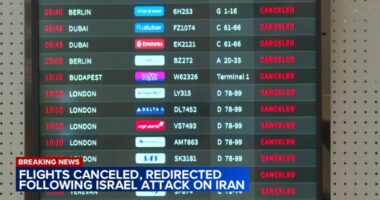NEWYou can now listen to Fox News articles!
Israel carried out a significant overnight strike on Iran, marking one of the most extensive aerial campaigns witnessed in recent history. This operation was not a spur-of-the-moment decision but rather the culmination of extensive planning, surveillance, and infiltration conducted by Israeli intelligence over an extended period.
While numerous fighter jets executed strikes on nuclear and military facilities in Iran during the early hours of Friday, the groundwork for this mission had been meticulously prepared by Mossad operatives in close collaboration with the Israeli military.
The operation, dubbed “Am Kelavi” or Rising Lion, was a pre-emptive move that underscored the remarkable level of coordination among various Israeli entities. The Israeli air force, the Military Intelligence Directorate, Mossad, and the nation’s defense industries had been working in tandem for years, pooling their resources and efforts to gather crucial intelligence required to neutralize Iran’s most critical military and nuclear installations.

People move past a large banner featuring portraits of slain leaders from Iran-aligned armed groups, including Hamas leader Yahya Sinwar, Hezbollah leader Hassan Nasrallah and Iranian Commander Qasem Soleimani, in central Tehran, Iran, on May 1, 2025. (Photo by MOHAMMADALI NAJIB/Middle East Images/AFP via Getty Images)
According to the same official, Iran’s military had gathered its top air force brass in one facility as part of a publicized drill meant to project deterrence. Instead, it exposed them. “It was partly luck, but also planned—the ability to see them in real time and strike with precision,” he said. “It’s a reminder of what happened in Lebanon—taking out contaminated leadership with surgical intelligence.”
That operation in Lebanon, often referred to as the “pagers” operation, saw Israel infiltrate and sabotage Hezbollah’s command network using Chinese-made radios embedded with explosives. The current operation, Israeli experts say, was broader, deeper, and more strategically impactful.
“I think this is so much more substantial,” said Nadav Eyal, an Israeli journalist and analyst for “Yediot Ahronot” newspaper. “What was done here was much more than the James Bond kind of type of pagers operation. It’s more about the infrastructure, intelligence needed to read devastating strikes on military installations, and the ingenuity of its intelligence services—electronic surveillance, things that it’s been developing for many years now.”
The Mossad’s infiltration campaign involved the quiet smuggling of sophisticated weaponry into Iran, hidden inside vehicles and embedded near strategic targets. In central Iran, precision-guided weapons were planted near surface-to-air missile batteries and launched on command. Disguised vehicles were also used to destroy Iran’s air defense systems at the moment of the strike. Meanwhile, explosive drones positioned near Tehran were activated to destroy long-range missile launchers at the Esfajabad base.
All of it took place under the watch of Iranian intelligence and succeeded without detection.
Israeli defense officials now say the mission represents one of the most successful intelligence-military integrations in the country’s history. If the Lebanon pagers stunned the world, the message from this strike is even clearer: nowhere is out of reach.

















